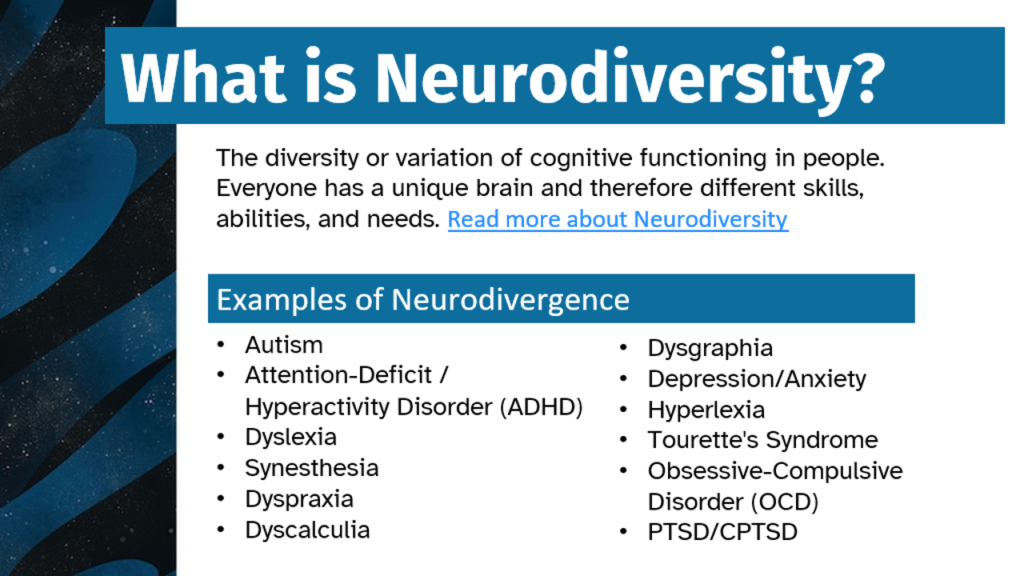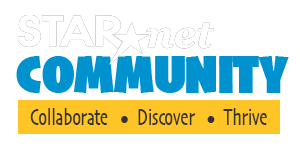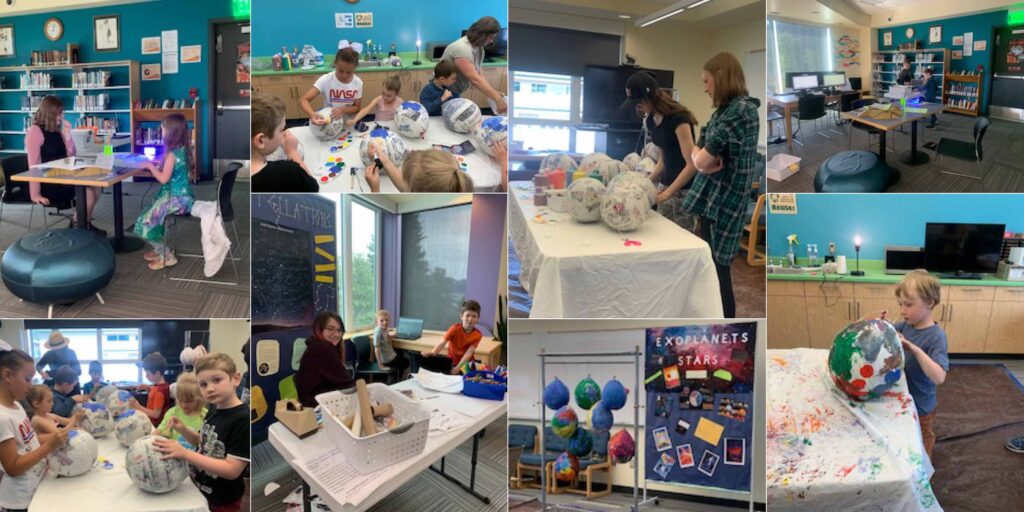Fostering Belonging in Neurodiverse Teams

By Jessica Santascoy (SSI)
The NASA@ My Library team, along with a consultant from Happily Autistic recently provided a presentation to other NASA Science Activation groups and Science Mission Directorate teams about fostering belonging and inclusion within a team that consists of both neurodivergent and neurotypical members. While many of our lessons learned came from our own interactions, we also were able to share ideas and concepts learned from observing the great work already happening in the library community.
The following blog post provides highlights from this presentation, as well as resources for further learning:
Library staff are committed to fostering diversity, equity, inclusion and accessibility in their communities (Fournier and Ostman). It’s often the case that people find a welcoming and safe environment at their own local public library.
Understanding and working proactively with neurodivergent colleagues is one of many strategies increase inclusion. “Neurodiversity describes the idea that people experience and interact with the world around them in different ways; there is no one “right” way of thinking, learning, and behaving, and differences are not viewed as deficits (Baumer and Freuh).”
In the image below, What is Neurodiversity?, there are some common examples of neurodivergence, and some that may surprise you, such as PTSD.

Below, we share three topics we discussed during the NASA Science Mission Directorate Training. Please note: We are unable to share the recording of this webinar due to privacy concerns, but we’re happy to schedule free webinars through state libraries or other large library consortium to present this resource live and answer questions. NASA@ My Library is proudly led by #actuallyautistic PI Anne Holland, and run by a group of neurodivergent and neurotypical staff. Anne is always happy to answer questions and may be reached at aholland@spacescience.org
What is meant by a “Spectrum?”
Most visuals that describe the spectrum are linear, and represent autism as mild to severe or low to high functioning. The graphic below, via Rebecca Burgess’ Understanding the Spectrum – A Comic Strip Explanation represents the spectrum in a nonlinear way. It shows how someone on the spectrum may have different traits than someone else on the spectrum. This is an important first step to recognizing that there is no “typical” form of most types of neurodivergence. In the case of autism, people are not high functioning versus low functioning. Instead, each individual has unique skills or care needs that don’t follow a pre-determined path or pattern. A non-verbal autistic person may need supports in communicating with colleagues, but excel at math and problem solving. Conversely, an autistic person can have expert communication skills, but need help with daily activities like feeding.

Tips for Reducing Misunderstanding
While it will never be possible to 100% alleviate misunderstandings or hurt feelings, there are some great tips for making incremental improvements. These tips can help your entire team feel more heard, leading to happier employees regardless of diagnosis! Some of these include:
- Be direct and set clear parameters and incremental deadlines. No one likes to guess if a task is for them, or what level of detail you want. Say what you mean and mean what you say!
- Follow verbal communication with written communication. Did you run into someone in the hallway and say “by the way, I really need you to get a draft of that document to me by next Friday. Make sure it has a, b, c, d, etc in it”? It happens to the best of us. If you find you’ve done this, immediately put that request into an email or other task system with clear instructions and deadlines. Hallway tasking is confusing tasking!
- Use a meeting platform with live captioning. Many folks have a hard time following and staying engaged with long talk only presentations/meetings. By turning on captioning, you’ve made it easier for folks who are hard of hearing, folks who learn better by reading, and provided an easy transcript for folks to search through later for important info!
- Break info and requests into smaller chunks. This is definitely dependent on the person you’re working with. Some folks will need tasks described in great detail, and others will revel in the opportunity to break the task up themselves into manageable and trackable bits. By allowing staff to use their own tracking systems and maintaining flexibility, they’re able to track their work (and request more information about their tasks) in a way that is most easy for them to understand.
Disclosing and Discussing Neurodivergence
During the training, a lot of folks wondered what to say when someone discloses their diagnosis. The right answer depends a lot on why they’re telling you! Is it because they want to share something with a close friend, because they feel they aren’t being understood and need a “reason”, or maybe to show solidarity with a colleague? If the situation isn’t tense, a simple “thanks for sharing that with me” is great. “Thanks for trusting me with this” is another option if they aren’t ready to be open to everyone. Again, read the situation and first understand why this information is being disclosed.
Perhaps more important than how to respond, is how not to respond. Here’s a list of bad responses gathered from some of our colleagues:
- I’m sorry to hear that
- You don’t look …….
- I never would have known/you hide it well
- No wonder you’re so good at math/why aren’t you good at math
- I have a “cousin, friend, sister, etc” who’s “diagnosis”
- Oh, just like “Temple Grandin, Sheldon Cooper, Rain Main, etc”
- Your support of Autism Speaks or your cute puzzle piece anything
- “We’re all a little autistic”
Do you have ideas on increasing a sense of belonging for patrons or for your team? We’d love to hear them – post in the comments or contact us.
Please feel free to utilize the slides from our presentation, available HERE.
These additional resources have also been provided by Happily Autistic:
Articles
Diagnosing Depression in People with Autism: A Guest Blog Post from SPARK – Part I by Marina Sarris via the Anxiety & Depression Association of America (ADAA)
The Consequences of Compensation in Autism by Tara Halle via Neurology Advisor
Half of Autistic Adults Feel A Low Sense of Well Being by Emily Willingham via Forbes
Most college grads with autism can’t find jobs. This group is fixing that. By Nicole Lyn Pesce via MarketWatch Moneyish
Neurodiversity as a Competitive Advantage by Robert D. Austin and Gary P. Pisano via Harvard Business Review Magazine (May-June 2017)
Double empathy, explained by Rachel Zamzow via Spectrum News
Websites
The Autistic Self Advocacy Network (ASAN)
Autistic Women & Nonbinary Network (AWN)
Citations
What is neurodiversity? By Nicole Baumer, MD, MEd and Julia Freuh, MD via Mind & Mood Harvard Health Publishing at Harvard Medical School. November 23, 2021.
Ask, Listen, Empower: Grounding Your Library Work in Community Engagement. Fournier, Mary Davis and Sarah Ostman, eds. ALA Editions, Chicago, 2021.





Wow, thank you for this great blog post! We spend part of our monthly staff meetings discussing a specific EDI issue, and this will be very useful!
Hi Kirsten! We’re so happy the blog article will be useful!